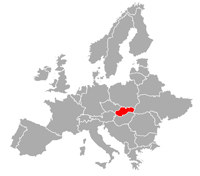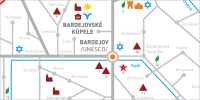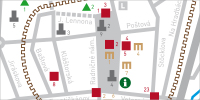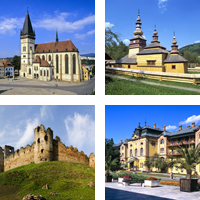The Historical Exhibition – The Free Royal Town of Bardejov
(Šariš Museum)
    The exhibition, located in the renaissance town hall (built 1505 – 1511), displays the economic, social and cultural history of Bardejov. Chronologically it spans from the first mention of the town in 1241 until the end of the eighteenth century. The fifteenth and the sixteenth century take most of the spotlight as it is the period when the town reached its apex of glory and wealth. The exhibition shows a highly developed economy including artisan’s trades, guilds, textile industry, and commerce. It also sheds light on local politics, law, town defense, medieval book culture, education and visual arts. Principal communication and documents were safeguarded in a small scriptorium and the local archive. The archives also host a precious collection of manuscripts (incunabula) made by the Augustinian monks of Bardejov. The most important items of the exhibition are the following: the sculpture of minor Calvary made by Master Paul of Levoča (1520), the altar of saint Nicolas (1524), the town’s seal (1453), chalices of gold and glass, gothic sculptures, renaissance epitaphs and a ring adorned with brilliants – a gift from the empress “Sissi” (Elisabeth of Bavaria). Other, more peculiar items of the exhibition include medieval graffiti on the ceiling of the former trade room as well as period swords, shackles and other “tools of the trade” of the local headsman. The interior decoration of the town hall conveys the importance and authority of the building. Each room is unique in its own style of architecture (decoration on portals, doors and arches). The principal room of the building is however the parlor of the town hall since the town’s leadership held council sessions in the room. The parlor’s compartment ceiling (built around 1508) serves as a beautiful example of period woodcarving work. The exhibition, located in the renaissance town hall (built 1505 – 1511), displays the economic, social and cultural history of Bardejov. Chronologically it spans from the first mention of the town in 1241 until the end of the eighteenth century. The fifteenth and the sixteenth century take most of the spotlight as it is the period when the town reached its apex of glory and wealth. The exhibition shows a highly developed economy including artisan’s trades, guilds, textile industry, and commerce. It also sheds light on local politics, law, town defense, medieval book culture, education and visual arts. Principal communication and documents were safeguarded in a small scriptorium and the local archive. The archives also host a precious collection of manuscripts (incunabula) made by the Augustinian monks of Bardejov. The most important items of the exhibition are the following: the sculpture of minor Calvary made by Master Paul of Levoča (1520), the altar of saint Nicolas (1524), the town’s seal (1453), chalices of gold and glass, gothic sculptures, renaissance epitaphs and a ring adorned with brilliants – a gift from the empress “Sissi” (Elisabeth of Bavaria). Other, more peculiar items of the exhibition include medieval graffiti on the ceiling of the former trade room as well as period swords, shackles and other “tools of the trade” of the local headsman. The interior decoration of the town hall conveys the importance and authority of the building. Each room is unique in its own style of architecture (decoration on portals, doors and arches). The principal room of the building is however the parlor of the town hall since the town’s leadership held council sessions in the room. The parlor’s compartment ceiling (built around 1508) serves as a beautiful example of period woodcarving work.
Location: Radničné námestie 48, Bardejov
More info: muzeumbardejov.sk
|
The Exhibition of Icons
(Šariš Museum)
    The unique exhibition of religious objects of the eastern tradition on the territory of Slovakia presents icons – a table shaped paintings of saints usually located on the church doors. The exhibition captures the development of icons of the Carpathian type from the sixteenth to the nineteenth century. Other items on display include canvas based icons, quilted priest attire as well as various furniture of eastern rite. The icons were displayed on several international exhibitions including Expo ’70 in Osaka, Japan. The unique exhibition of religious objects of the eastern tradition on the territory of Slovakia presents icons – a table shaped paintings of saints usually located on the church doors. The exhibition captures the development of icons of the Carpathian type from the sixteenth to the nineteenth century. Other items on display include canvas based icons, quilted priest attire as well as various furniture of eastern rite. The icons were displayed on several international exhibitions including Expo ’70 in Osaka, Japan.
Location: Radničné námestie 27, Bardejov
More info: muzeumbardejov.sk
The Museum of Folk Architecture
(Šariš Museum)
    The open air museum in Bardejovské Kúpele (Bardejov Spa) is the oldest exhibition of its kind in Slovakia. The museum hosts 24 objects on the area of 1.5 hectares which represent Slovak and Ruthenian folk culture and architecture of the upper Šariš and upper Zemplín regions. The buildings, fashioned in the Carpathian wooden style, originated in the eighteenth, nineteenth and the twentieth century. There are four major types – peasant houses, outbuildings, mechanical facilities and sacral buildings. The most significant buildings of the exhibition are the wooden churches of Mikulášová (dated 1730) and Zboj (dated 1775), eighteen century facilities for the production of wooden water pipes as well as the “valcha” (a fuller-device for domestic production of cloth) dated to 1888 and originally found in the village of Livov. The open air museum in Bardejovské Kúpele (Bardejov Spa) is the oldest exhibition of its kind in Slovakia. The museum hosts 24 objects on the area of 1.5 hectares which represent Slovak and Ruthenian folk culture and architecture of the upper Šariš and upper Zemplín regions. The buildings, fashioned in the Carpathian wooden style, originated in the eighteenth, nineteenth and the twentieth century. There are four major types – peasant houses, outbuildings, mechanical facilities and sacral buildings. The most significant buildings of the exhibition are the wooden churches of Mikulášová (dated 1730) and Zboj (dated 1775), eighteen century facilities for the production of wooden water pipes as well as the “valcha” (a fuller-device for domestic production of cloth) dated to 1888 and originally found in the village of Livov.
Location: Bardejovské Kúpele
More info: muzeumbardejov.sk
|
The Etnographic Exhibition, The History of Bardejovské Kúpele Exhibition and The Apothecary Exhibition
(Šariš Museum)
    The Ethnographic Exhibition presents the development of folklore and traditional crafts of the upper Šariš region. It displays traditional clothing, handicrafts such as pottery, candle making, shingle-making, coopery, hat-making, flute-making as well as sacral art in the form of sculptures and painted glass. The History of Bardejovské Kúpele Exhibition, on the other hand, focuses on the spa history of Bardejov. The third exhibition hosts genuine nineteenth century Apothecary apparatuses. All exhibitions are located in the Villa Rákóczi in Bardejovské Kúpele (Bardejov Spa). Among the most interesting pieces on display are: the oldest Slovak beehive from 1691, a folk garb from the village of Zlaté (dated 1850), sacral folk art, apothecary utensils, historical photographs of the spa of Bardejovské Kúpele and last but not least a cup of healing water from which in 1821 drank the Russian czar Alexander I. The Ethnographic Exhibition presents the development of folklore and traditional crafts of the upper Šariš region. It displays traditional clothing, handicrafts such as pottery, candle making, shingle-making, coopery, hat-making, flute-making as well as sacral art in the form of sculptures and painted glass. The History of Bardejovské Kúpele Exhibition, on the other hand, focuses on the spa history of Bardejov. The third exhibition hosts genuine nineteenth century Apothecary apparatuses. All exhibitions are located in the Villa Rákóczi in Bardejovské Kúpele (Bardejov Spa). Among the most interesting pieces on display are: the oldest Slovak beehive from 1691, a folk garb from the village of Zlaté (dated 1850), sacral folk art, apothecary utensils, historical photographs of the spa of Bardejovské Kúpele and last but not least a cup of healing water from which in 1821 drank the Russian czar Alexander I.
Location: Bardejovské Kúpele
More info: muzeumbardejov.sk
The Exhibition of Natural Sciences
(Šariš Museum)
    The Exhibition of Natural Sciences displays local flora and taxidermy of northeastern Slovak fauna. Over 1700 native showpieces are supplemented by further examples of exotic fauna (collected from all of Europe, north Asia, north Africa, America, China and Cuba). Major showpieces are represented by endangeredbreed of aSouth American Condor, a rare Slovak snail Pagodulina pagodula, a young of a Caribbean shark, reticulated python, as well as by a collection of American hummingbirds. The Exhibition of Natural Sciences displays local flora and taxidermy of northeastern Slovak fauna. Over 1700 native showpieces are supplemented by further examples of exotic fauna (collected from all of Europe, north Asia, north Africa, America, China and Cuba). Major showpieces are represented by endangeredbreed of aSouth American Condor, a rare Slovak snail Pagodulina pagodula, a young of a Caribbean shark, reticulated python, as well as by a collection of American hummingbirds.
Location: Rhodyho 4, Bardejov
More info: muzeumbardejov.sk
|
The gallery of Šariš Museum
    The exhibition hosts artists and their work from Slovakia as well as abroad. The exhibition hosts artists and their work from Slovakia as well as abroad.
Location: Radničné námestie 13, Bardejov
More info: muzeumbardejov.sk
The gallery of the Polish-Slovak House
    The exhibition hosts artists and their work from Slovakia as well as abroad. The exhibition hosts artists and their work from Slovakia as well as abroad.
Location: Radničné námestie 24, Bardejov
More info: ktcbardejov.sk
|




























